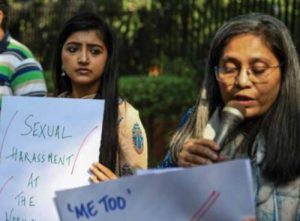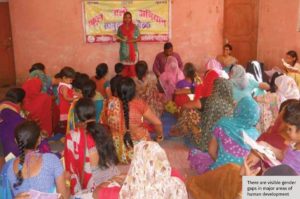 Imagine when you think that you have made a name for yourself, your family and made the nation proud by your accomplishments, you expect people around you to laud your achievements. They will praise your work but in the same breath ask you “Well you have achieved all this, but when are you settling down?” For them settling down means getting married and having kids. Damn with your career, your ambition, your dreams, and your commitments to do something for your family and society. Even close relatives become part of that system if you don’t get married until a certain age.
Imagine when you think that you have made a name for yourself, your family and made the nation proud by your accomplishments, you expect people around you to laud your achievements. They will praise your work but in the same breath ask you “Well you have achieved all this, but when are you settling down?” For them settling down means getting married and having kids. Damn with your career, your ambition, your dreams, and your commitments to do something for your family and society. Even close relatives become part of that system if you don’t get married until a certain age.
Why marriage a defined path for every woman in India to explain her personality? Nobel Prize winner, George Bernard Shaw wrote, “It is a woman’s business to get married as soon as possible, and a man’s to keep unmarried as long as he can.” That defines the psyche of patriarchal society.
Why insist on marriage when data from different sources show that nearly 74.1 million women in India are either divorced, separated, widowed or have never been married? Why marriage remains the only acceptable fate for young women in India? Whereas a third of Japanese women and 11% of Sri Lankan women aged 30-34 are single, less than 3% of Indian women are single at that age.
Why women, whether single by choice or circumstances, though professionally successful, are under scrutiny by society? Is it blasphemous to be single in India?
Glorious past
Women during the Vedic period enjoyed equal status with men in all aspects of life. Women were married at a mature age and were probably free to select their own husbands in a practice called “swayamvar” or live-in relationship called “Gandharva” marriage. A man was not allowed to abandon his wife. There was no division of property between a husband and a wife because they were linked inextricably together and had joint custody of the property.
The wife could make gifts and use the family wealth on her own. Similarly, daughters would inherit property. Also, in the “Puranas”, every God was shown in the consort of their wives — Brahma with Saraswati, Vishu with Laxmi and Shiva with Parvati. Ideals of god and goddess were depicted with equal importance to both genders. The purdah system and Jauhar are aberrations.
Constitutional guarantees
Article 14 of the Constitution of India guarantees to all-Indian women equality. Article 15(1) says there cannot be any discrimination by the State. Article 16 allowed equality of opportunity while Article 39(d) gave equal pay for equal work. In the recent past, the Sexual Harassment of Women at Workplace (Prevention, Prohibition and Redressal) Act, 2013 was passed to protect women from sexual harassment at their place of work.
The Act came into force from 9 December 2013. Later an amendment made acid attacks a specific offense with a punishment of imprisonment not less than 10 years and which could extend to life imprisonment and with fine. On 22 August 2017, the Supreme Court of India deemed instant triple talaq (talaq-e-biddat), unconstitutional. In 2018, the Supreme Court of India struck down a law making it a crime for a man to have sex with a married woman without the permission of her husband.
The Indian Armed Forces began recruiting women to non-medical positions in 1992, while the Border Security Force (BSF) began recruiting female officers in 2013. On 25 March 2017, Tanushree Pareek became the first female combat officer commissioned by the BSF.
Women have come of age. As last year’s #MeToo movement and Sabarimala protests showed, Indian women are echoing their rebellion. Is it because women have been suppressed for long and improvement in their educational levels have made them realize their potential? The moment “school chalen” (let’s go to school) has brought out a transformation in girl education and girls are doing better than even their male counterparts in education. In 2018, in the Class XII CBSE examination, 88.31% of girls passed, compared to 78.99% boys in all streams-science, humanities, and commerce.
19% less salary for women
They why this discrimination? Why women in India earn 19 per cent less than men? Indeed gender pay gap is still high in India, as women in the country earn 19 per cent less than men, and wage inequalities in favour of men are present in all the relevant sectors, a survey said. According to the latest Monster Salary Index (MSI), the current gender pay gap in India stood at 19 per cent where men earned 46.19 more in comparison to women. The median gross hourly salary for men in India in 2018 stood at 242.49, while for women it stood at around 196.3.
According to the survey, the gender pay gap spans across key industries. The IT and ITES services showed a sharp pay gap of 26 per cent in favour of men, while in the manufacturing sector, men earn 24 per cent more than women. Surprisingly, even in sectors like healthcare, caring services, and social work, men earn 21 per cent more than women, even as notionally these sectors are more identified with women, the survey said.
Financial services, banking, and insurance is the only industry where men earn just 2 per cent more, it added. According to the report, the gender pay gap widens with the years of experience. In the initial years, the gender pay gap is moderate but rises significantly as the tenure increases. For those with over 10 years of experience, the gender pay gap in favour of men reaches the peak, with men earning 15 per cent more than women. In 2018, the gap has narrowed only by one per cent from 20 per cent in 2017. The MSI is an initiative by Monster India in collaboration with Paycheck.in (managed by WageIndicator Foundation) and IIM-Ahmedabad as a research partner.
Monster.com has also conducted the Women of India Inc survey aimed at understanding the working women of India and their workplace concerns which noted that 71 per cent men and 66 per cent women feel that gender parity needs to be a top priority for their organisations. As high as 60 per cent of the working women felt that they are discriminated at work. The survey says that there is a perception that women are less serious about work once they are married. About 46 per cent women feel that maternity leads to a perception that they will quit. About 46 per cent women also believe that there is a notion that women can’t put the same number of hours as men.
Enquility in jobs
One can notice another disparity. Young men with Class 10 or 12 education can find jobs as mechanics, drivers, sales representatives, postmen and appliance repairmen. But few of these opportunities are available to women.
National Family Health Survey data suggests, 48% of women with no schooling do not go to a health centre alone; the proportion for college graduates is only slightly lower at 45%.
It is a double whammy for India because touted as world’s fastest economy; India has gained the double distinction of being the most dangerous country for women. A World Bank report released on July 11, 2018, suggested that the Indian economy has now become the world’s sixth-biggest pushing France to seventh place.
The US leads the table as the biggest economy followed by China, Japan, Germany, and Britain. However, a survey released recently has found that India is the world’s most dangerous country for women due to the high risk of sexual violence and being forced into slave labour.
Stung by the global survey, the tourism ministry sent a letter to heads of Indian missions, highlighting a series of initiatives the country has taken to promote women’s safety. The July 6, 2018 letter from the Tourism Secretary challenged the survey pointing out that “results have not been derived from any kind of proper data and are solely based on the subjective opinion of 548 respondents”.
As per the survey, the war-torn Afghanistan and Syria ranked second and third in the Thomson Reuters Foundation survey of about 550 experts on women’s issues, followed by Somalia and Saudi Arabia. The only western nation in the top 10 was the United States, which ranked joint third when respondents were asked where women were most at risk of sexual violence, harassment and being coerced into sex. Experts said India moving to the top of the poll showed not enough was being done to tackle the danger women faced, more than five years after the rape and murder of a student on a bus in Delhi made violence against women a national priority.
The survey asked respondents which five of the 193 United Nations member states they thought were most dangerous for women and which country was worst in terms of healthcare, economic resources, cultural or traditional practices, sexual violence and harassment, non-sexual violence and human trafficking. Respondents also ranked India the most dangerous country for women in terms of human trafficking, including sex slavery and domestic servitude, and for customary practices such as forced marriage, stoning, and female infanticide.
While India faired poorly in this survey, experts said the surprise addition of the United States in the top 10 most dangerous countries for women came down to the #MeToo and Time’s Up campaigns against sexual harassment and violence that have dominated headlines for months. India, Libya, and Myanmar were considered the world’s most dangerous nations for women exploited by human traffickers in a global crime worth an estimated $150 billion a year.
The poll of 548 people was conducted online, by phone and in person between March 26 and May 4 with an even spread across Europe, Africa, the Americas, South East Asia, South Asia, and the Pacific. Respondents included aid professionals, academics, healthcare staff, non-government organisation workers, policy-makers, development specialists and social commentators.
The world’s most dangerous countries for women according to the survey are India (1), Afghanistan (2) and Syria (3), Somalia (4), Saudi Arabia (5), Pakistan (6), Democratic Republic of Congo (7), Yemen (8), Nigeria (9) and United States (10).
UNDP Index
The United Nations Development Programme’s Gender Inequality Index shows India ranks at number 130, while Norway stands at number one, Switzerland at number two and China at number seven. Inequality Gender inequality remains a major barrier to human development. Girls and women have made major strides since 1990, but they have not yet gained gender equity.
The disadvantages facing women and girls are a major source of inequality. All too often, women and girls are discriminated against in health, education, political representation, labour market, etc.—with negative consequences for the development of their capabilities and their freedom of choice.
The GII is an inequality index. It measures gender inequalities in three important aspects of human development — reproductive health, measured by maternal mortality ratio and adolescent birth rates; empowerment, measured by proportion of parliamentary seats occupied by females and proportion of adult females and males aged 25 years and older with at least some secondary education; and economic status, expressed as labour market participation and measured by labour force participation rate of female and male populations aged 15 years and older.
The GII is built on the same framework as the IHDI — to better expose differences in the distribution of achievements between women and men. It measures the human development costs of gender inequality. Thus the higher the GII value the more disparities between females and males and the more loss to human development.
The GII sheds new light on the position of women in 160 countries; it yields insights in gender gaps in major areas of human development. The component indicators highlight areas in need of critical policy intervention and it stimulates proactive thinking and public policy to overcome the systematic disadvantages of women.
There could be several reasons for India’s poor ranking in the survey but India faces twin problems in dealing with crimes against women. India is one of the world’s most under-policed countries with about 130 policemen per 100,000 people while even Pakistan has 207, USA has 256 and UK over 300. More policemen on the streets would be a stronger preventive measure against crime against women. The other problem is the patriarchal mindset as female foeticide continues and successive census showing skewed female ratio vis-à-vis male ratio. There is a need for India to shed the veil of conservatism and give respect, equality to women.
letters@tehelka.com














